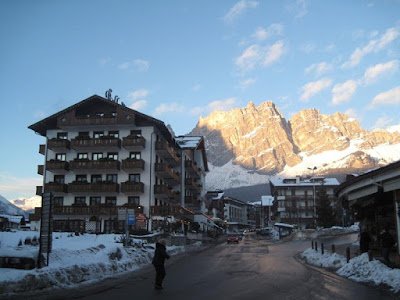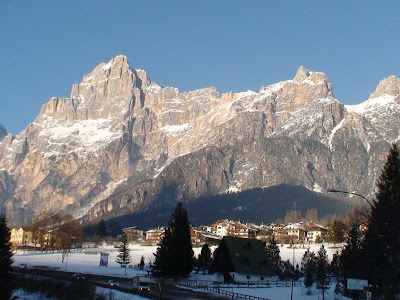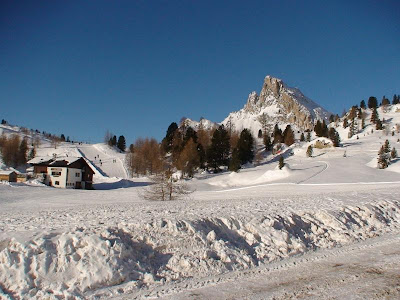Affordin' Cortina
Now I must admit, I didn’t see many Fords in Cortina, and while that may be hard to explain, as you see them all over Europe, the appreciation in the Dolomite! I can see you groaning, but then puns have never been my Ford eh! Mind you, in and around Cortina it is mainly Rollers or Mercedes, and the poor man’s BMW, the Audi, that you see in abundance, with only the occasional distinctive Alfa grill, filling your mirrors. It appears that even the Italians have ‘gone wider European’, although I must admit to being passed by a new Fiat Bambini! But while the Alps are really the old Rockers of Europe, the Dolomites are very much the Punks, sharp and abrasive, tall and imposing, and boy, do they command your attention! And they are at their gob-smacking best in the area around Cortina d’Ampezzo, the ‘capital’ of the mountains. Oh, old towns like Belluno and Bolzano, ancient keepers of the paths and passes through which the invader came, Barbarians to Napoleon, to the Kaiser, lay prior claim, but brash Cortina will hear none of it and it constantly challenges, in an “Are you looking at me, punk” sort of way.
But first I need to back up a bit! We left Lake Bled in driving snow, our windscreen wipers like small earth-movers in the conditions, with us peering like moles suddenly risen to the surface. Given the number of tunnels that one strikes in Europe, it is a most apt simile for in such tunnels, which often twist, duck, and turn for ten to fifteen kilometres, you feel very mole or worm-like in the darkness, and can readily claim membership of a spelunking society! But when we shot out of the tunnel and back into Austria, we were greeted by blue skies and sunshine, and a bridge on nimble leggings that it looked like one of those things from The War of the Worlds! Hundreds of feet below, swirled rushing white-turquoise water, and even from the warmth of our little Skoda heater, it looked cold, while swivelling our heads upwards, there was only the snowy grandeur of the Alps. And they looked cold too!
We stopped briefly at a way-side station, which in Austria, lets the eyes press the button to start the gastric juices flowing. The spread of food and drink available, is simply unbelievable, and laid out before you with all the delight and detail of a Klimt painting! Everything is spotlessly clean and inviting, although the seating, strangely, is arranged for the smokers, and the more Godly, in a manner that is surprising to still find in juxtaposition, long after most European eating establishments have been declared smoke free. A picture-postcard cake and double espresso later, we rejoined the autobahn. "Punch Cortina into the GPS please, darling" I instructed like a gay airline captain, and a minute later, the waspish “Jane” told me to “Follow the motorway”. It was only when we had long been in Italy, and the mountains receded further in my rear vision mirror, and “Jane” told me to take the highway which said boldly, Venice, that I started to sniff a rato. Sure enough, at the next petrol station, the newly purchased map showed that we were headed for Cortina near Milano! After giving TomTom a severe thrashing and simply ignoring “Jane” like one might an errant wife, we turned northwards again, for Belluno, and the Dolomites.
Now while the countryside in Tuscany, Umbria, Puglia, and a host of other Italian regions is pleasing to the eye, the plains of Venice are by comparison, waif-like. It is plain and flat country, the villages look dull and dirty, the houses grubby and unkempt, and there are a plethora of factories, light industry buildings, and sale-yards. And they all need a good scrubbing. What is worse, is that there is a different village every few hundred metres, and they all have 50 kph speed limits! Have you tried to drive a car, on a main road, at 50 kph, with an Italian motorista all over your back windscreen and not giving a dead Duce about any speed limit? You can almost hear their ‘bastardo’ when they finally whiz by, and I assume that they are not all trying to show me the ring on their finger! Then again, it is only the tourist who takes seriously a Carabineiri who dress like General MacArthur, ‘fruit salad’ and all, (and take themselves just as seriously!), and who drive a baby-blue coloured police cars! “Now come on!”, I hear you say. Prego!
We reached Belluno, perched like a stork’s nest atop an acropolis, but except for a pizza bar in the central piazza, it being Sunday, everything else was closed. So, in brilliant sunshine, we headed for Cortina d’Ampezzo, and like, I imagine, disrobing Sophia Loren, the natural beauty, especially the mountains, became more and more stunning as we got closer to the prize! Topped with snow, the Dolomites were all russet and ochres, golden where the rays of the sun struck them, and in the valleys, there were snow embedded villages, with chalets and churches, pine forests and ski runs, tennis courts looking like white bowling greens. And then, we were in Cortina itself, with its wide pedestrian main street, and its exclusive brand-name shops like those which grace the Champs Elysee, the Via Veneto and Rodeo Drive. And everywhere, there were people in ‘exclusive’ ski gear, ladies in Mink and Arctic Fox, Sable and Chinchilla, usually on the arm of a Fedora wearing, Burberry-scarfed, camel-hair coated, gentleman, strolling and window shopping, fashionable snow boots coping with the snow and ice. We ventured into a shop looking like Morris dancers at a Stones concert, and saw that the parkas had been “specially reduced to Eu 800, and that there was a thirty percent reduction on fur coats, down from Eu 2000, although I must say, I didn’t recognize the Lapin label! Be assured, Cortina is spelled “serious money”.

Cortina d’Ampezzo, the ‘capital’ of the Dolomites
We stayed in a dark-as-a-dog-box pensione, with “Meuble” in the title, and I judged it to be a furniture factory with second-hand beds tossed in. The television only showed Italian programs, and the choice wavered between Berlusconi, Mussolini and Cicciolina, so we turned it off, while the shower was boiling or freezing with no in-between. Still, it was quiet, the beds were firm, and it was on the outskirts of the town centre, with a pizza place next door which made McDonalds seem haute cuisine. But after a beer and a cappuccino, all for Eu 20 in a ritzy bar, where the waiter clearly thought I had trodden in a dog turd, the pizza place was just fine. Outside, on the billboards were images of thin, chiselled Italian men, with blue eyes and square jaws, hair that looked as though it had its own Gulf oil well in attendance, and stubble as though a fire-swept wheat field! But hey, where are those guys? Everywhere we went, the women looked every bit ciao bella, but the men looked like Friar Tuck in hairstyle and girth, veritable Danny de Vito’s in a cardigan, with bad teeth and smelling of tobacco!

The splendour of the Dolomites
For us, Cortina d’Ampezzo was a quick ‘look see’ stop, beautifully set, but it was a place you needed to visit on Silvio B’s expense account We breakfasted well, although the Pecorino cheese was so tough that it seemed Uri Geller guided my knife, and the meat was more morta than della. We left quickly, and drove through the town where already large numbers were waiting for the bus to take them to the slopes, all looking swank and swish in their designer beanies, puffer parkas, and holding their Atomic skis with not a Bikini at all in sight, even though the sun’s rays bounced from the dazzling snow. We sought the Falzarego High Pass to Corvara, but the Italians have a habit of putting the direction signs right in the corner of a junction. A bit like putting a sign “Iceberg” on the one that got the Titanic, I suppose, but we eventually found our way out of town with a lot of kangaroo-hopping and tooting. Patience in Italy, is not in abundance. Why testosterone simply has to have an Italian root!
We climbed via switchbacks, up and up, each corner more breathtaking than the former. As always, the Dolomites were the star, the garnishing snow, merely the foot-lights. We ran out of superlatives, and stopped often, when the wow factor was simply overwhelming. Everywhere there were ski runs, with seldom more than a few skiers. So too, were there great mounds of snow, or the snow covered swathes between the pine trees, often with a nearby small coffee place or a bar to go off piste. How I wished I had drunk at the fountain of youth, because it looked so much fun! We crossed the pass at 2150 metres, and stopped to take in the magnificent, tranquil vista, the only sound being the swish of skiers. It was hard to imagine that in World War I, this had been the scene of heavy fighting between the Italian and Austrian forces. Now there were fairy-book wooden chalets, a million pine trees, and timber yards very much a growth industry.
While we saw signs to look out for deer, we saw none, but later, when we drove into the little mountain town of La Villa, there were plenty of lodgings with antlers on the front door, and many in the bars themselves. Italians, although not alone in this, are renown for shooting and stuffing almost anything that moves, for Benelli, Beretta, and even Fiat make shotguns. And what could be more machismo than shooting a field mouse or a finch, probably the only beasties still left around to hunt!

At the Falzarego Pass; one of the many ski slopes above Cortina
There was no breeze, and the sun was out, real Ray Bans and Tee Shirt weather, and in the small coffee shop we found, there was a gelato stand. I looked at the hills of ice-cream and thought that they had merely taken some snow from the Dolomites and added a bit of colouring. No wonder the Italians excelled in making gelato – they had the example right there before them! We gave it a miss, and followed a twisting road along a sunless canyon floor, to Brunico, where a sign told us it was minus 9 degrees. The high pass to Austria was closed because of heavy snowfalls and so we set TomTom for Lienz. The Alps were with us again, huge and majestic against the blue sky, but somehow they seeming more sedate than the Dolomites, and when we crossed the border at Ansbach, watched over by its impressive castle, and switched on the radio, the music was Mozart. Everything was immediately tidy again. It was easy to see we were back in Austria.
Winfred Peppinck is the Tales of the Travelling Editor for Wandering Educators




















